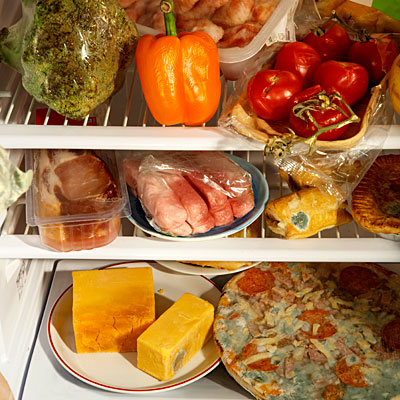
Do you have a hard time sticking to a meal plan or a diet program? Stop scheduling and counting—listening to your body might be the only direction you need.
According to a new study in the Journal of the Academy of Nutrition and Dietetics, eating mindfully—consuming food based on how hungry and full you feel throughout the day—can be just as effective for weight loss in adults with Type 2 diabetes as following a nutrition plan.
Study participants were divided into two treatment groups. One group followed a nutrition program that educated participants about healthy food choices, interpreting food labels, and rules for dining out. The second group did not receive specific nutrition objectives and was trained in a mindful approach to food selection and eating. People in both groups lost an average of 3 1/2 to 6 pounds and both reduced their blood sugar levels considerably after three months.
How does the mindful approach work? Lisa Young, PhD, RD and author of The Portion Teller, says a better understanding of your body can have a huge impact. “When you are more aware of your eating habits, you pay better attention to what, when, and why you are eating,” she says.
And the “why” may be the most important factor to consider. “Everyone has different reasons that cause them to overeat—some are bored, or sad, or happy, or dining in a group—but realizing what causes it can help you better monitor the habit,” Young says.
Want to incorporate a more mindful method to your day? Try these three tips.
Keep a Food Diary
By tracking what you consume, you can better highlight the reasons you eat and which parts of the day you are most hungry. Use the journal not only to note which kinds of foods and how much you eat, but also to track your level of hunger. “Eat just enough to keep yourself in the middle of the scale,” Young says. “If you are at a one [starving], you tend to not make healthy choices.”
Chew Slowly
Eating slower and taking smaller bites will also help you be more in tune with what your body needs, says Young. And don’t forget to make friends with your dishes! “Do not eating standing and do not eat out of the box—put all your food on a plate or in a bowl,” Young says. By pre-plating your food, it is easier to eyeball correct portions and the visual cue will assist your resolve at the end of your meal.
Snack Smart
Can’t help but nibble? Reach for Young’s snack of choice—popcorn. She likes it because it is a whole grain (the fiber helps you feel fuller longer), and you don’t have to stop at just one kernel. “Three cups of popcorn is a serving, so you get a lot more bang for your buck,” she says. Turn your next bowl into a superstar snack with these six yummy popcorn recipes.
Image: iStockphoto/Thinkstock
More from WH:
The Hunger Paradox
Lose Weight with Portion Control
The Truth About Serving Sizes




![osbourne-food-portion-2[3]](http://blog.womenshealthmag.com/thisjustin/files/2012/10/osbourne-food-portion-23.jpg)
![osbourne-food-portion-3[3]](http://blog.womenshealthmag.com/thisjustin/files/2012/10/osbourne-food-portion-33.jpg)
![osbourne-food-portion-1[3]](http://blog.womenshealthmag.com/thisjustin/files/2012/10/osbourne-food-portion-13.jpg)



 “, board_url: “http://www.health.com/health/gallery/comments/0,,20392188,00.html”});Comment.render_comments_count();}); Vignette StoryServer 6.0 Mon Aug 20 11:41:40 2012 S
“, board_url: “http://www.health.com/health/gallery/comments/0,,20392188,00.html”});Comment.render_comments_count();}); Vignette StoryServer 6.0 Mon Aug 20 11:41:40 2012 S SweepstakesHealth NewsettersSubscribeHealthy & HappyNews & ViewsFamilyHome and TravelMind and BodyMoneySex and RelationshipsDiet & FitnessFitness • Cardio • Strength • YogaWeight Loss • Diets • Dieting TipsFood & RecipesEating • Cooking • Nutrition • Restaurants and Fast FoodsRecipesBeauty & StyleBeauty • Skincare • Hair • Makeup • StyleCelebrity • Celebrity Tips • Celebrity HealthHealth A-ZAlzheimer’s DiseaseAsthmaBipolar DisorderBirth ControlBreast CancerChildhood VaccinesCholesterolChronic PainCold, Flu, and SinusCOPDCrohn’s DiseaseDepressionDiabetes (Type 2)FibromyalgiaGERDHeadaches & MigrainesIncontinenceMenopauseOsteoarthritisOsteoporosisRheumatoid ArthritisSexual HealthSleep DisordersUlcerative ColitisMore ConditionsMagazineCurrent IssueSubscribeTablet EditionArchiveGive a Gift SubscriptionCustomer ServiceMedia KitAge-Proof Your BonesHome >> Food & Recipes >> Eating >> Cooking >> Moldy food is a fact of life. Even if you do everything right, like refrigerating food promptly, mold can still show up in your favorite fare. Comments: Add | Read
SweepstakesHealth NewsettersSubscribeHealthy & HappyNews & ViewsFamilyHome and TravelMind and BodyMoneySex and RelationshipsDiet & FitnessFitness • Cardio • Strength • YogaWeight Loss • Diets • Dieting TipsFood & RecipesEating • Cooking • Nutrition • Restaurants and Fast FoodsRecipesBeauty & StyleBeauty • Skincare • Hair • Makeup • StyleCelebrity • Celebrity Tips • Celebrity HealthHealth A-ZAlzheimer’s DiseaseAsthmaBipolar DisorderBirth ControlBreast CancerChildhood VaccinesCholesterolChronic PainCold, Flu, and SinusCOPDCrohn’s DiseaseDepressionDiabetes (Type 2)FibromyalgiaGERDHeadaches & MigrainesIncontinenceMenopauseOsteoarthritisOsteoporosisRheumatoid ArthritisSexual HealthSleep DisordersUlcerative ColitisMore ConditionsMagazineCurrent IssueSubscribeTablet EditionArchiveGive a Gift SubscriptionCustomer ServiceMedia KitAge-Proof Your BonesHome >> Food & Recipes >> Eating >> Cooking >> Moldy food is a fact of life. Even if you do everything right, like refrigerating food promptly, mold can still show up in your favorite fare. Comments: Add | Read  Credit: Getty Images
Credit: Getty Images
















 Free Food & Nutrition Email Newsletter
Free Food & Nutrition Email Newsletter
 26 Quick and Tasty Zucchini Recipes2
26 Quick and Tasty Zucchini Recipes2 12 Secrets to Better Orgasms3
12 Secrets to Better Orgasms3 Best Superfoods for Weight Loss4
Best Superfoods for Weight Loss4 Quiz: Do You Have Adult ADHD?5
Quiz: Do You Have Adult ADHD?5 25 Diet-Busting Foods You Should Never Eat6
25 Diet-Busting Foods You Should Never Eat6 The Best Fat-Burning Breakfasts > Take Health magazine with you, try 2 FREE PREVIEW issues Add your commentThe rules: Keep it clean, and stay on the subject or we might delete your comment. If you see inappropriate language, e-mail us. An asterisk * indicates a required field.
The Best Fat-Burning Breakfasts > Take Health magazine with you, try 2 FREE PREVIEW issues Add your commentThe rules: Keep it clean, and stay on the subject or we might delete your comment. If you see inappropriate language, e-mail us. An asterisk * indicates a required field.
